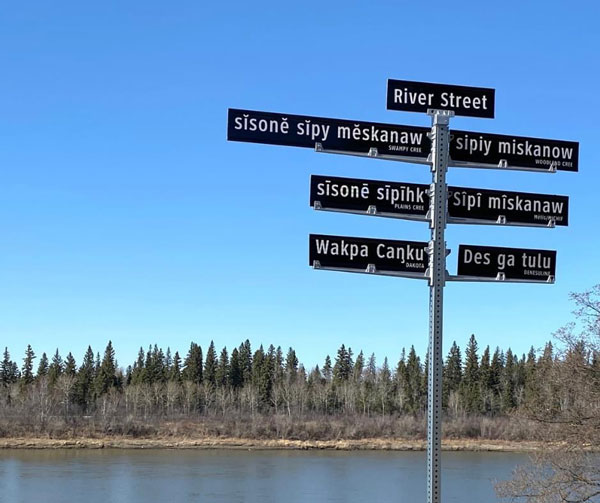Prince Albert’s River Street will be the first location named under the City’s Indigenous Naming Initiative. Signs will be installed on River Street at 1st Ave West, 1st Ave East and 6th Ave East, translated in the City’s six Indigenous languages: Plains Cree, Swampy Cree, Woodland Cree, Dakota, Dene and Métis.
The project is part of the City’s Municipal Cultural Action Plan (MCAP) and approved by City Council following recommendations from the Historical Society’s First Nation and Metis Knowledge Keeper Committee.
Judy MacLeod Campbell, Arts and Cultural Coordinator for the City of Prince Albert explained that the entire project is important so people have a sense of belonging in the community.
“When we looked at this idea, which is certainly in other cities and places throughout Canada and throughout the world. It’s really a way to recognize the population that we have and a community that we have and really try to be as reflective of that population as we can be. In particular this is an Indigenous naming initiative but down the road it could expand much more beyond and that is because the intent is to really look at our community and be inclusive of our community,” she explained.
The committee assisted with prioritizing and recommending names and locations to present to the City’s Community Services Advisory Committee and City Council.
The location was chosen in part because of the significance of the river to Indigenous communities as the historical meeting place.
MacLeod Campbell explained that the city did some groundwork looking at what was potentially available and unnamed.
“We brought all of that kind of information to the Knowledge Keepers Committee and they were the ones, they had several ideas and a couple priorities as being. It is so relevant that it seemed like a really good place to start,” she added.
In a release she explained the purpose of the initiative is also to acknowledge the history of the people who lived on these lands before settlers arrived. It will also serve as an opportunity to reflect and honour the contributions of the Indigenous community in Prince Albert.
As of this moment 42 per cent of Prince Albert identifies as Indigenous but they were only able to identify nine locations in the city have an Indigenous name.
“That is clearly not representative of the population,” MacLeod Campbell said.
She explained the community is made up of many parts and many people.
“There’s so much more that can be done and this initiative has helped us to start that conversation and begin to reflect on the people, places and names that are appropriate for Prince Albert,” she added in the release.
A number of other names and locations were also considered by the Knowledge Keeper Committee with a recommendation to consider a welcome sign in Indigenous languages.
As part of the project, an inventory of current and potential places and spaces for Indigenous naming was initiated by a City of Prince Albert staff and Historical Society working group. Part of this inventory was the identification of places and spaces that cannot or should not be named due to existing sponsorship agreements, emergency service response and spaces already named.
The MCAP identifies actions to make Prince Albert a stronger cultural community. This initiative is part of ongoing work of the MCAP to ensure that all nations, communities, newcomers and individuals are welcomed and celebrated in the community while working toward achieving the recommendations identified in the Truth and Reconciliation Commission Calls to Action.The Knowledge Keepers are a committee of the Historical Society which includes representatives from each of the five First Nations cultures in, and members of, the Prince Albert Grand Council as well as five Metis Knowledge Keepers from the community.
MacLeod Campbell said that future plans for the MCAP include a history project around Little Red River Park.
“That used to be the ancient Dakota village, the Dakota people then moved to Wahpeton. So we are doing some work there with first starting with the story, so there was a village there of Dakota people prior to Little Red River Park and how it got its name. That is our next project related to this initiative,” she said.


